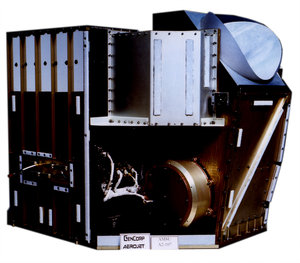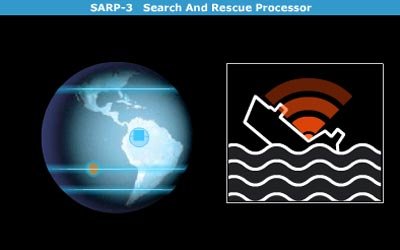Technical summary
Advanced Data Collection System (ADCS) CNES
Collection of oceanographic, atmospheric and/or meteorological 400 bit/s or 4800 bit/s data on 401.65 MHz from platform transmitters (PTT) on buoys, ships, land sites and balloons worldwide for later relay to ground via X-band and HRPT. Determines PTT location by Doppler. Can transmit to PTTs on 466 MHz at 200 bit/s or 400 bit/s. 24 kg, 7.5 kbit/s, 64 W.
Advanced Microwave Sounding Unit (AMSU-A1/A2) NOAA
Step-scan 15-channel microwave radiometers for 50 GHz oxygen absorption line, 2000 km swath, IFOV 30 km (nadir). A1/A2: 55/50 kg, 2.1/1.1 kbit/s, 78/30 W.
Advanced Scatterometer (ASCAT) ESA
5.255 GHz C-band radar scatterometer with three dual-swath (2 x 500 km width, offset 384 km left/right of ground track) antennas (fore/mid/aft) for measurement of radar backscatter at three azimuth angles to provide surface wind vectors of 4-24 m/s with accuracy ± 2 m/s & ± 20°, spatial resolution 50 km (25 km experimental), 0.57 dB radiometric accuracy. Incidence angle range 25-65°, 10 ms pulses of 120 W peak power. Additional products such as sea-ice cover, snow cover and vegetation density. 270 kg, 60 kbit/s, 251 W.
Advanced Very High Resolution Radiometer (AVHRR/3) NOAA
6-channel visible/IR (0.6-12 µm) imager, 2000 km swath, 1 x 1 km resolution. Global imagery of clouds, ocean and land. 35 kg, 622/39.9 kbit/s (high/low rate), 27 W.
Global Ozone Monitoring Experiment (GOME-2) ESA/EUMETSAT
Scanning spectrometer, 250-790 nm, resolution 0.2-0.4 nm, 960 km or 1920 km swath, resolution 80 x 40 km or 160 x 40 km. Double monochromatic design: first stage of quartz prism with physical separation of four channels (240-315, 311-403, 401-600, 590-790 nm); second stage of blazed grating in each channel. Detector: 1024-pixel random-access Si-diode arrays. Ozone total column & profiles in stratosphere & troposphere; NO2 BrO OClO ClO. Albedo and aerosol; cloud fraction, cloud-top altitude, cloud phase. 73 kg, 40 kbit/s, 45 W.
GNSS Receiver for Atmospheric Sounding (GRAS) ESA/EUMETSAT
GPS satellite occultation (up to 500/day) receiver for bending angle measurement better than 1 µrad, fitting data to stratospheric model for temperature profile (vertical sounding of ± 1K with vertical resolution of 150 m in troposphere (5-30 km altitude) and 1.5 km in stratosphere), retrieval of refractive index vs. altitude profile. 30 kg, 60 kbit/s, 42 W.
High-resolution Infra-Red Sounder (HIRS/4) NOAA
20-channel optical/IR filter-wheel radiometer, 2000 km swath, IFOV 17.4 km (nadir). 35 kg, 2.9 kbit/s, 21 W. Replaced on MetOp-C by IASI.
Infrared Atmospheric Sounding Interferometer (IASI) CNES/EUMETSAT
Fourier-transform spectrometer, 3.62-15.5 µm in three bands. Four IFOVs of 20 km at nadir in a square 50 x 50 km, step-scanned across track (30 steps), synchronised with AMSU-A. 2000 km swath. Resolution 0.35 cm-1. Radiometric accuracy 0.25-0.58K. Integrated near-IR imager for cloud discrimination. Water vapour sounding, NO2 & CO2 , temperature sounding, surface & cloud properties. 251 kg, 1.5 Mbit/s, 240 W.
Microwave Humidity Sounder (MHS) EUMETSAT
5-channel quasi-optical heterodyne radiometer, 190 GHz (water vapour absorption line), 89 GHz (surface emissivity), 2000 km swath, IFOV 16 km (nadir). 66 kg, 3.9 kbit/s, 89 W.
Search & Rescue (SARP-3/SARR) CNES/NOAA
Relay of distress beacon signals; 121.5/243.0/406.05 MHz uplink from EPIRB (Emergency Position Indicating Rescue Beacon), 1544.5 GHz 2.4 kbit/s downlink. 35 kg, 77 W.
Space Environment Monitor (SEM-2) NOAA
Multi-channel charged particle spectrometer as part of NOAA's 'Space Weather' activities. Total energy of electron & proton fluxes 0.05-1 keV and 1-20 keV; directional & omni measurements in six bands 30-6900 keV for protons and three bands 30-300 keV for electrons. 18 kg, 166 bit/s, 6 W.















 Germany
Germany
 Austria
Austria
 Belgium
Belgium
 Denmark
Denmark
 Spain
Spain
 Estonia
Estonia
 Finland
Finland
 France
France
 Greece
Greece
 Hungary
Hungary
 Ireland
Ireland
 Italy
Italy
 Luxembourg
Luxembourg
 Norway
Norway
 The Netherlands
The Netherlands
 Poland
Poland
 Portugal
Portugal
 Czechia
Czechia
 Romania
Romania
 United Kingdom
United Kingdom
 Slovenia
Slovenia
 Sweden
Sweden
 Switzerland
Switzerland








































